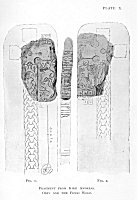
Sacred Texts Legends/Sagas Celtic Iceland Index Previous


Click to enlarge
PLATE X.
FIG. 1. FIG. 2.
FRAGMENT FROM KIRK ANDREAS.
ODIN AND THE FENRI WOLF.
Lastly (pl. X.), I show a very interesting little piece from Andreas. Unfortunately, like so many others, it is but a fragment.
One face (fig. 1) bears, below the right arm of the cross, a figure of a Man with a Spear attacked by a Wolf; above his shoulder a Raven.
Undoubtedly this is Odin, 1 who meets the monstrous Fenri Wolf in the dreadful Day of Doom, of which we are told by the Sybils in "Volu-spa":--"The Ash of the Steed of the Hanged One shall quiver, and there shall be no part of heaven and earth that shall not then tremble for fear. The Anses shall put on their harness, and all the host of the Elect (Einherjarnir), and go forth to the field. Odin shall ride first with his golden helm and his fair mail-coat, and his spear that is called Gungnir (Tusker). He shall challenge the Wolf Fenri. . . . The Wolf shall swallow Odin, and that shall be his bane." Then she relates how "straightway Widar (the silent) shall dash forward and rend the Wolf's jaws asunder, and that shall be its death. . . . Thereupon Swart shall cast fire over the earth and burn the whole World. And every living
thing shall suffer death . . . and the Powers shall perish!"
Not only have we here the end of Odin but the end of the old gods, of the old beliefs! Turn we now to the other face of the stone (fig. 2), and what do we behold?
"Then there shall come One yet mightier; Though Him I dare not name."
So far the Sibyl; and, our Sculptor figures a Man, belted, in his right hand a Cross, in his left a Book. He treads upon adders and knotted worms. In front is a Fish, without doubt the Christian symbol--ίχθυς. Christ has over-come the powers of Evil, and He now reigns in Odin's stead!
___________________________________________________________
Bemrose & Sons, Ltd., Printers, London, Watford, and Derby.
29:1 Odin on Sleipner, the Wolf, Heimdall, and Widar rending the Wolf's jaws appear on the Gosforth Cross, that wonderful monument, the deciphering of which, by Mr. Calverley, led the Rev. G. F. Browne, lecturing at Cambridge in November, 1882, to remark--"It is not too much to say that this year has seen a revelation of the language of these stones, which no one had dreamed of before."